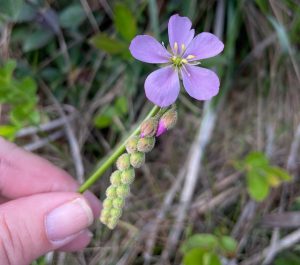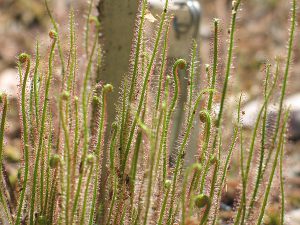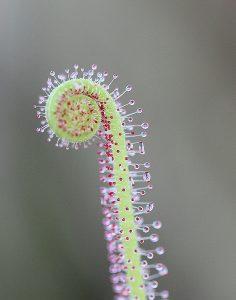
I love bogs. The mucky, sunny spaces here in northwest Florida are inevitably full of beauty and surprises. Due to the sopping wet, acidic, and nutrient poor soil, plants in these areas must make some unusual adaptations. As I have written in this blog before, wetland bogs are home to several interesting and carnivorous species, like pitcher plants and sundews. Most sundew species I come across are the tiny, pinwheel shaped dwarf sundews (Drosera brevifolia), which lie prone to the ground.

At a recent visit to the Roy Hyatt Environmental Center, I noticed a showy purple flower that at first I assumed was a meadow beauty. Lavender, four-petaled meadow beauty flowers are common in wet areas. However, this plant was a bit different. First, it had five petals; but even more unusual was that something akin to a green caterpillar was hanging from every flower bloom. Intrigued, I bent closer and saw that the green segments were not a dangling invertebrate, but a series of fuzzy green flower buds. The bud closest to the purple flower was a deep violet and close to flowering.

In all my years of exploring and leading people around pitcher plant prairies, I’ve encountered Tracy’s sundew/threadleaf sundew (Drosera tracyi)—a type of sundew with an upright, sap-covered stem—but never one in bloom.

Typically, you’ll only come across the slender, threadlike ( a structure known as “filiform”) fiddlehead leaves. These leaves look more like stems, and are bright green and covered in dewy, sticky, deadly-to-insects droplets. Insects are attracted to the shimmering drops of mucus, triggering a hormone in the plant that causes the leaf and its glands to fold over the prey. Once stuck, the insects suffocate and are digested by enzymes in the leaf glands.
The purple flowers appear in May or June, atop a single leafless stem that appears unattached to the threadleaf sundew leaves. According to the Georgia Biodiversity Portal, this series of flowers will “open one by one, from the bottom of a coiled inflorescence up, with unopened buds at the top. Flowers begin to open about 9:00 am and close about five hours later; some flowers persist for two days.” Threadleaf sundews can self-pollinate but are also attractive to bees.
 1
1
